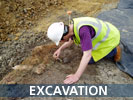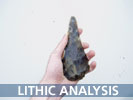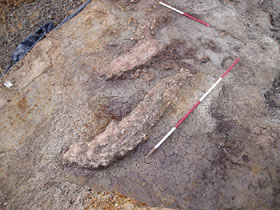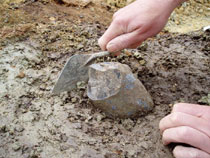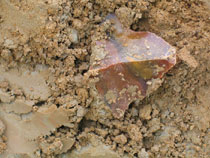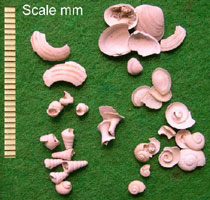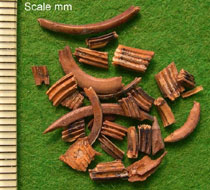|
CTRL Southfleet Road Clactonian elephant site, Ebbsfleet Routine archaeological monitoring in November 2003 led to the identification of some potentially interesting fluvial gravels at the southwestern edge of the Ebbsfleet Valley, revealed by groundworks in advance of construction of the main access road to the Ebbsfleet International Station car-park. More detailed investigation revealed an undisturbed palaeo-landsurface within the sequence of deposits under the fluvial gravels, with flint artefacts and faunal remains, including the skeleton of a straight-tusked elephant.
The elephant skeleton and the other faunal remains are found within the boggy sediments at what would have been the edge of a small lake or pond. It is uncertain whether the elephant was deliberately driven into the boggy ground and then killed, or whether it became trapped on its own. The manufacture of stone tools at the same spot, which would have been unsuitable for human occupation, almost certainly reflects butchery of the carcass for its meat. The skeleton is surrounded by a scatter of refitting flint debitage and (to-date, excavations are still in progress) six cores. This may be indicative of the band-size of the Clactonian group that exploited the carcass. The flint artefacts are typical of the Clactonian
industry, comprising cores, large utilised flakes and notched flakes.
Large numbers of artefacts have been found, many made on good quality
flint, with not a hint of handaxe manufacture. This confirms that
the Clactonian is a genuine phenomenon in the Lower Palaeolithic,
which some, strangely, have doubted, despite the manifest evidence
to the contrary.
Fig. 2, a and b. Clactonian artefacts from the Southfleet Road palaeo-landsurface The site is also notable for the abundance and good quality of the associated environmental remains. Sieving of the lake-side sediments at the site has produced a wide range of evidence that reveal the climate and local environment, as well as helping date the site. The presence of sticklebacks, frogs, newts and aquatic molluscs confirm the presence of standing water at the site. The presence of pollen grains from a number of tree species - including birch, pine, oak, elm, alder and hazel - and teeth from a woodmouse indicate an interglacial climate, similar to or warmer than the present day, with the lake surrounded by woodland, probably with some open areas due to heavy grazing. Most importantly, the presence of two species
of vole - water vole (Arvicola cantiana) and pine vole (Pitymys arvaloides)
- allow the site to be accurately dated by means of the so-called
"vole clock". Investigations at sites across Europe have
allowed construction of a detailed framework of how different vole
species evolved over the last million years, and where and when specific
species became extinct. Of the two vole species found at the Ebbsfleet
site, the pine vole has been extinct in England for the last 400,000
years and the type of water vole found has only been present for the
last 500,000 years. Taken together, the two species help to date the
site to the Hoxnian interglacial, a warm phase for which deposits
are also preserved at nearby Swanscombe.
Fig. 3, a and b. Molluscs and small vertebrate remains from the Southfleet Road Clactonian site. References |
|
 |
 |
 |
 |
